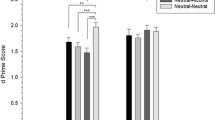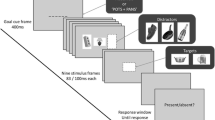Abstract
Rationale. Understanding the cognitions underpinning substance use has stalled using the Stroop paradigm.
Objective. To employ a novel version of the flicker paradigm for induced change blindness to independently compare information processing biases in social users of alcohol and cannabis.
Method. Alcohol and cannabis experiments were independently run. In both, participants were asked to view successively and repeatedly on a monitor two versions of a visual scene (an original and a slightly changed version) until the change was detected. In fact, in both experiments two simultaneous changes competed for detection: a substance-neutral and a substance-related change.
Results. In both the alcohol and the cannabis experiments, participants detecting the substance-related change reported higher levels of use than those detecting the substance-neutral change.
Conclusion. A substance-related processing bias was independently revealed for both substances. The utility of the flicker paradigm for substance use research is demonstrated as sensitive and quick to administer (taking only 1 min).
Similar content being viewed by others
Author information
Authors and Affiliations
Additional information
Electronic Publication
Rights and permissions
About this article
Cite this article
Jones, B.C., Jones, B.T., Blundell, L. et al. Social users of alcohol and cannabis who detect substance-related changes in a change blindness paradigm report higher levels of use than those detecting substance-neutral changes. Psychopharmacology 165, 93–96 (2002). https://doi.org/10.1007/s00213-002-1264-2
Received:
Accepted:
Issue Date:
DOI: https://doi.org/10.1007/s00213-002-1264-2




